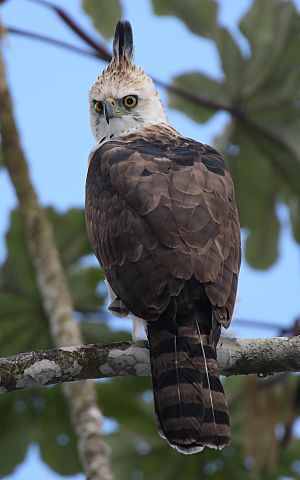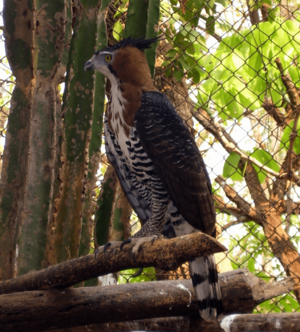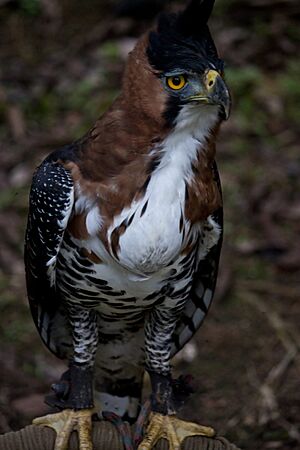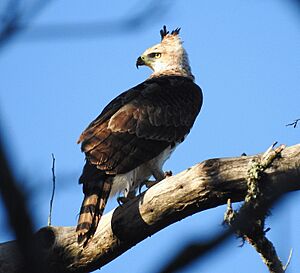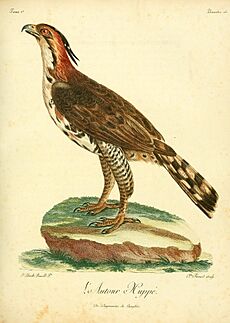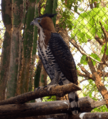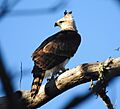Ornate hawk-eagle facts for kids
Quick facts for kids Ornate hawk-eagle |
|
|---|---|
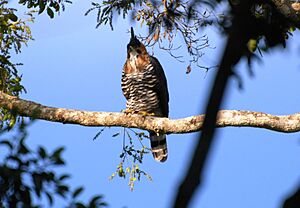 |
|
| A wild adult in Campeche, Mexico | |
| Conservation status | |
| Scientific classification | |
| Genus: |
Spizaetus
|
| Species: |
ornatus
|
| Subspecies | |
|
|
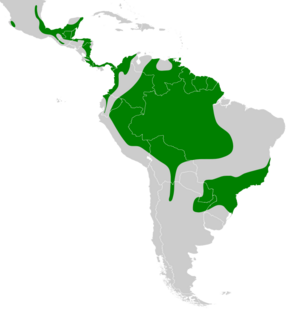 |
|
The ornate hawk-eagle (Spizaetus ornatus) is a large bird of prey. It lives in the warm, tropical parts of the Americas. Some people used to call it the "crested hawk-eagle." But this name is now mostly used for an eagle species in Asia. Like all eagles, it belongs to the Accipitridae family. This eagle has feathers on its lower legs, which means it is a "booted eagle."
Adult ornate hawk-eagles have bright colors and bold patterns. Young birds look very different, with much whiter feathers. These eagles live from central Mexico all the way south through Central America. Their range also spreads into South America, especially in Brazil and down to northern Argentina. You can usually find them in old, tall forests.
Female ornate hawk-eagles almost always lay just one egg. They have a long breeding cycle, like many birds of prey in the tropics. Young eagles stay with their parents for a long time after they learn to fly. This eagle is a strong hunter. It eats many different animals, usually medium to large birds and small to medium mammals. Sometimes, it also eats reptiles.
Sadly, this species is facing a big threat from deforestation. This means forests are being cut down. Because their forest homes are shrinking, especially in the Amazon rainforest, the IUCN (a group that tracks animal populations) listed the ornate hawk-eagle as Near Threatened in 2016.
Contents
About the Ornate Hawk-Eagle
What are Booted Eagles?
The ornate hawk-eagle is part of the "booted eagle" group. These eagles have feathers all the way down their legs. This is a special feature shared by many eagles around the world. The ornate hawk-eagle is one of four types of "hawk-eagles" that live in the Americas. Long ago, hawk-eagles from Asia were thought to be in the same group. But scientists now know they are different.
Studies of old eagle bones show that many kinds of hawk-eagles used to live in North America. Some of these ancient eagles were much bigger than today's hawk-eagles. They might have been as large as the modern harpy eagle.
Scientists have also studied the genes of these eagles. They found that the black-and-white hawk-eagle and the black-and-chestnut eagle are closely related to the ornate hawk-eagle. The black hawk-eagle is a bit different from the others. The ornate hawk-eagle and the black-and-chestnut eagle are considered "sister species." This means they are very closely related.
Different Types of Ornate Hawk-Eagles
There are two main types, or subspecies, of the ornate hawk-eagle:
- S. o. ornatus: This type lives in much of South America. This includes eastern Colombia, Venezuela, and most of Brazil.
- S. o. vicarius: This type lives in Mexico, Central America, and parts of western Colombia and Ecuador.
These two types look a bit different as adults. The S. o. ornatus has a lighter, more cinnamon color on its neck. It also has fewer markings on its head and belly. The S. o. vicarius is darker overall. It has a richer, deeper reddish-brown color on its neck. It also has more markings and wider bands on its tail.
Appearance and Size
Ornate hawk-eagles are medium to large birds of prey. But they are fairly small eagles compared to some others. Males and females look similar. However, females are usually larger than males. The biggest female eagles can be 13% larger than the biggest males. On average, females are about 8% heavier. In some parts of Central America, a large female can weigh 50% more than a small male.
Adult ornate hawk-eagles are about 56 to 68.5 centimeters (22 to 27 inches) long. Males average about 60 cm (23.5 in) and females 63 cm (25 in). Their wings can spread from 117 to 142 cm (3 ft 10 in to 4 ft 8 in). Males usually weigh between 835 to 1,215 grams (1.8 to 2.7 pounds). Females are heavier, from 950 to 1,760 grams (2.1 to 3.9 pounds).
Their tail length is about 24.4 to 29 cm (9.6 to 11.4 in). The beak is about 2.5 to 3.1 cm (1 to 1.2 in) long. Their lower leg (tarsus) is 8.7 to 10 cm (3.4 to 3.9 in) long. The largest back talon (claw) is very big for its size. It averages about 3.6 to 3.9 cm (1.4 to 1.5 in) long. This claw is their main tool for hunting. Their foot span is about 13.5 cm (5.3 in) wide.

Ornate hawk-eagles often sit quietly in the treetops. Sometimes they sit on open branches, especially in the morning. They usually soar high in the sky in the late morning. Adults are easy to spot because of their reddish-brown neck and bold stripes on their belly.
All ornate hawk-eagles have a long crest of feathers on their head. They can raise this crest straight up or lay it flat. Adults have a black crown and crest. They also have black stripes on their face. Their cheeks and neck are reddish-brown. This color often covers their upper chest. Their back and wings are dark brown or blackish. They have white tips on some feathers. Their belly is whitish with bold black stripes. These stripes go down to their legs.
Young eagles look very different. They do not have the reddish-brown neck or the stripes on their belly. Their whole head and belly are white. They only have thin black streaks on their crown and crest. Their back and wings are dark brown with white-tipped shoulders. Their tail is similar to adults but has a wider white tip and more thin bands.
By their second year, young eagles start to look more like adults. Their face becomes a sandy or pale reddish-brown. Their belly and legs start to show stripes. Their back becomes more blackish. Adult eagles have orange-yellow eyes. Their beak and bare skin around the eyes are dull green to gray. Their feet are cream to pale yellow. Young eagles have white to yellowish eyes. Their beak is yellow to bluish-gray, and their feet are brighter yellow or orange.
In flight, they look like a medium-sized eagle. They have a large head and short, broad, rounded wings. Their flight is strong and deep. Their wings are held flat and slightly forward. From above, adults have a reddish-brown neck and blackish back and wings. Their underwings are paler with some spots and thin stripes. Young eagles in flight are dark brown above. Their underwings have scattered spots and thin stripes.
Similar Birds
Adult ornate hawk-eagles are easy to tell apart from most other birds. But young gray-bellied hawks look very similar. This might be a case of mimicry. A smaller bird (the hawk) might copy a stronger bird (the hawk-eagle) to avoid being attacked. You can tell them apart by their size and shape. Gray-bellied hawks are smaller and have shorter, broader wings. They also have a different flying style.
Black hawk-eagles are similar in shape and size when flying. But they are a bit larger and have longer tails and wings. However, ornate hawk-eagles are usually a bit heavier. Adult black hawk-eagles are much darker, almost solid black. Young black hawk-eagles might be confused with young ornate hawk-eagles. But young black hawk-eagles have more stripes on their belly and dark cheeks.
Young ornate hawk-eagles can also be confused with the black-and-white hawk-eagle. But the black-and-white hawk-eagle is smaller. It has boxier wings, a shorter crest, and a strong black mask. It also has a plain white belly. Young ornate hawk-eagles are told from young black-and-chestnut eagles by their smaller size. They also have more spots and stripes under their wings.
Other birds like the hook-billed kite and gray-headed kite can look similar to young ornate hawk-eagles. But these kites are much smaller and have different body shapes. The crested eagle looks somewhat similar to the ornate hawk-eagle. But it is much larger and has a longer tail. It is also lighter for its size. The harpy eagle is much, much bigger than the ornate hawk-eagle. It is nearly five times heavier. So, it is unlikely to be confused with the ornate hawk-eagle.
Calls and Sounds
The main call of the ornate hawk-eagle is a series of loud, whistling sounds. It is often heard when the bird is soaring. It sounds like "whi whee-whee-wheep." The "whee" part can be repeated many times. This call is different from the black hawk-eagle's call. The ornate hawk-eagle's call starts faster and ends with a longer note.
When perched, they might make a "ca-lee-oo" sound. This is followed by excited, laughing notes. Other calls include a "qu-ouw" sound, like a limpkin. They might also make a cat-like scream if they are disturbed. Young eagles make a loud, clear whistle when they want food. It sounds like "wheeu" or "wheee."
When the male brings food to the nest, he makes a "pitpit" call four times. The female often makes a "hui" note when she wants food. She repeats it about four times. She might also make a sharp "fli-fli-fli-flio" sound if small birds bother her.
Where They Live and Their Home
The ornate hawk-eagle lives in the largest area of all nine eagle species in the Americas. Their total range covers about 20.2 million square kilometers (7.8 million square miles). These eagles usually stay in one place. But some young birds might travel to drier forests or higher mountains.
They live as far north as southeastern Mexico. They are found almost everywhere in Central America. This includes Belize, Guatemala, El Salvador, Honduras, Nicaragua, Costa Rica, and Panama. In Panama, they are more common on the humid Caribbean side.
In South America, they live west of the Andes mountains. They are more common north and east of the Andes. This includes Colombia, Venezuela, Trinidad and Tobago, Ecuador, and the Guianas. In Brazil, they live in almost two-thirds of the country. Their range also goes through eastern Peru, Bolivia, Paraguay, and northern Argentina. Even though they live in a large area, they are often rare in many places.
These eagles live in dense forests. They prefer tall, wet, tropical, and subtropical forests. They usually live only in untouched, old-growth forests. If too many trees are cut down, the eagles will leave the area. Ornate hawk-eagles can be found from sea level up to 1,500 meters (4,900 feet) high. Sometimes, they are seen as high as 1,800 meters (5,900 feet). They can even wander up to 3,000 meters (9,800 feet) in Costa Rica. They do well in cloud forests, which are usually higher up than typical rainforests.
Sometimes, they might visit forest edges, riverbanks, or other open areas. They can also be found in forests along rivers or in swamp forests. They might even nest in some secondary forests or coffee plantations if there are tall native trees. In Guatemala, they prefer thick, primary forests. They especially like areas with very tall trees that stick out above the rest of the forest. This helps them hunt more easily.
What They Eat
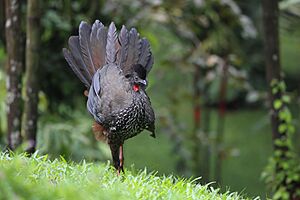
The ornate hawk-eagle is a strong hunter. It eats two main types of prey: medium to large birds and small to medium mammals. Sometimes, they also eat reptiles. They usually hunt inside forests. They often perch on a branch and wait. Then, they fly quickly to catch prey on the ground or in trees. They are very agile and can chase prey through the trees. This is why they are called "hawk-eagles," like the "true hawks."
They often chase large gamebirds like chachalacas, guans, and curassows. In fact, some local people call them the "guan hawk" or "curassow hawk." They eat at least twelve types of these birds. But they also eat many other kinds of birds. About 65% of their diet is birds. Other important bird prey include tinamous, pigeons, doves, toucans, and parrots.
In one large study in Tikal, Guatemala, the most common bird prey was the keel-billed toucan. This made up about 11% of their diet. Other common birds were the plain chachalaca and the great tinamou. In this study, birds made up about 56% of their food. Another study in Brazil found that birds made up about 63% of their diet. The most common bird prey there was the dusky-legged guan.
At both Tikal and Brazil, the most common prey overall was mammals. In Tikal, Yucatan squirrels and Deppe's squirrels were the most common. They made up about 28% of the diet. In Brazil, large rodents like agoutis were the most common. These rodents are often active during the day.
They also eat animals like raccoons, white-nosed coatis, and kinkajous. They usually hunt young animals of these larger species. They also hunt New World monkeys. They mainly hunt smaller monkeys like squirrel monkeys, tamarins, and marmosets. Larger monkeys are sometimes hunted, but usually only young ones. Monkeys are hard to catch because they are very careful and have good ways to protect themselves.
Other mammals they eat include bats, opossums, and silky anteaters. They have even been seen eating a bush dog. They rarely eat reptiles like lizards and snakes.
The size of prey they catch can vary a lot. Most birds they eat weigh between 160 grams and 3.8 kilograms (0.35 to 8.4 pounds). The smallest prey they have eaten is a Jamaican fruit bat (50 grams or 1.8 ounces). The smallest bird prey was a long-tailed silky-flycatcher (36.3 grams or 1.3 ounces).
Even though they are powerful, the average size of their prey is not huge compared to their own weight. In the Tikal study, the average prey size was about 517 grams (1.1 pounds). This is about 34-42% of the eagle's own body weight. They can catch prey that weighs up to four times their own weight. This includes large birds like the great curassow and the ocellated turkey, which can weigh 5 kilograms (11 pounds) or more. Mammals like the Central American agouti can weigh up to 3.8 kilograms (8.4 pounds). They also hunt large green iguanas, which average about 4 kilograms (8.8 pounds). When they catch very large prey, they cannot fly with it. They will return to the kill many times to eat it.
Sharing the Forest with Other Hunters
Ornate hawk-eagles share their home with many other birds of prey. This includes other strong eagles. Scientists believe these different eagles find ways to live together without too much fighting. They likely do this by eating different kinds of food.
For example, the ornate hawk-eagle often prefers larger birds like guans and toucans. It also eats small mammals that are active during the day. But the black hawk-eagle often hunts small mammals that are active at night, like bats. The black-and-white hawk-eagle seems to prefer slightly smaller birds, like pigeons.
The black-and-chestnut eagle eats similar prey to the ornate hawk-eagle. But it lives in high mountain forests, so they do not usually meet. Other eagles like the solitary eagle eat mostly snakes. The crested eagle prefers medium-sized mammals, including monkeys. The harpy eagle mainly hunts sloths and large monkeys.
It seems that different eagles in the tropics hunt different sizes of monkeys. Smaller eagles like the ornate hawk-eagle hunt smaller monkeys. Crested eagles hunt medium-sized monkeys. Harpy eagles hunt the largest monkeys.
Forest eagles in the Americas seem to get along surprisingly well. They rarely fight with each other. Only vultures sometimes make nesting ornate hawk-eagles aggressive. This might be because some vultures steal eggs. In one case, a camera near a harpy eagle nest showed a pair of ornate hawk-eagles doing a breeding display nearby. Both species seemed to ignore each other.
Life Cycle and Reproduction
Ornate hawk-eagles live alone or in pairs. They protect their breeding areas by flying in circles high in the sky. This display usually happens in the late morning. Sometimes, one bird will fly like a butterfly, with shallow wing beats. The male might also do noisy acrobatics to impress the female. In a special display, the pair glides in tight circles. The male approaches the female from above. The female rolls onto her back, and they grab each talons.
The size of their home area changes with the seasons. It can be from 0.6 to 2 square kilometers (0.2 to 0.8 square miles). In Tikal, Guatemala, adult eagles used an area of about 10 to 14 square kilometers (3.9 to 5.4 square miles). Sometimes, they would go as far as 19.5 square kilometers (7.5 square miles).
Ornate hawk-eagles usually breed only every other year. They will breed more often if their last nesting attempt failed. Birds in tropical areas often have longer breeding cycles than birds in colder places. They also usually have fewer young. This is especially true for large forest birds in the tropics. They take a very long time to care for their young after they learn to fly.
The breeding season in Central America is usually from December to September. In Brazil, it is mostly from August to January. They seem to lay their eggs in the dry season. The young birds then learn to fly in the early wet season. In Tikal, eggs were usually laid in mid-March.
Nests
This species builds a large nest made of sticks. Nests are always built in trees. The nest is usually 20 to 30 meters (66 to 98 feet) above the ground. They often choose the tallest tree in the forest. This tree usually sticks out above the other trees.
In Tikal, many nests were found in Honduran mahogany trees and kapok trees. Nests are placed on open branches, often in the main fork of the tree. A typical nest is about 1 to 1.25 meters (3.3 to 4.1 feet) wide. It is about 50 centimeters (20 inches) deep. One very deep nest was 1.5 meters (4.9 feet) deep.
Eggs
Ornate hawk-eagles usually lay only one egg. All nests found in the wild have had only one egg. The eggs are mainly white with a few brownish or reddish spots. They are not shiny and feel a bit rough. In Tikal, the eggs averaged about 60.2 x 45.3 millimeters (2.37 x 1.78 inches). They weighed about 75.5 grams (2.7 ounces).
Parental Care
Before the egg is laid, the female stays near the nest most of the time. The male is around less often. Both before and during incubation, the female often collects green leaves to line the nest. She does this almost every day.
The female does most of the incubation. She sits on the egg for about 95-97% of the time. The male usually catches prey and brings it to the female while she is incubating. When he brings food, the male and female might call to each other for several minutes. They exchange the prey foot-to-foot. The female will immediately remove the head from mammal prey or the beak from bird prey.
Both parents protect their young from predators. The female is especially protective. Vultures can make them aggressive. The female might raise her crest, cover her egg, and call loudly. Mammals that eat eggs cause a stronger defense. For example, female eagles have been seen attacking red-faced spider monkeys and Geoffroy's spider monkeys. In one case, a female eagle knocked a tayra (a large weasel-like animal) out of the nest tree twice.
Studies in Guatemala show that female ornate hawk-eagles are very aggressive towards humans near the nest. They often strike researchers, even if they are wearing protective gear. In one case in Mexico, the male eagle struck a researcher. However, in some areas of Brazil, females were less aggressive towards humans. They did not even react to workers using chainsaws near the nest.
Growing Up
The young eagles hatch at different times, depending on when the eggs were laid. In Tikal, most hatching happened between February and June. This time likely matches when other bird species are learning to fly, making them easy prey.
When they first hatch, the eaglets are very helpless. They cannot even lift their heads for the first few days. By about two weeks old, they can start to stand on their folded legs in the nest. They start begging for food more loudly around three weeks old. At 36 days, they might try to peck at carcasses. But they cannot feed themselves well until about 52 to 54 days old.
Their wing and tail feathers start to grow at 39 days. By eight weeks, the eaglet can stand, flap its wings, and play with sticks in the nest. A week later, they become more independent. They mostly feed themselves and start to move out of the nest onto nearby branches. They often flap their wings a lot.
Young eagles learn to fly (fledge) between 60 and 93 days old. In Tikal, the average age for fledging was 77.5 days. At 12 weeks, they have their full juvenile feathers. Even after they can fly, young hawk-eagles stay near the nest for months. They usually do not go further than 100 to 170 meters (330 to 560 feet) from the nest. They often beg loudly for food.
At 11–12 months old, young eagles might start to soar around their parents' territory. Around one year of age, they likely try to hunt for the first time. They become fully independent around 11.5 to 12 months old. The average age of independence in Tikal was 15.4 months.
Scientists believe they become adults and can breed at about two years old. This is when they get their subadult feathers. There is little proof that they breed before three years of age. In one case, a pair of subadult eagles was seen breeding. This pair also killed and ate a young eagle from another territory.
Compared to other eagles, ornate hawk-eagles become independent faster than some larger species. For example, harpy eagles do not become adults until about five years old.
Status and Threats
The ornate hawk-eagle is naturally rare, like many large birds of prey. However, its numbers have been going down. Because of this, in 2012, it was listed as Near Threatened. Today, there are an estimated 13,300 to 33,300 ornate hawk-eagles left. This is a very small number for a species that lives in such a large area.
In Brazil's Atlantic Forest, the ornate hawk-eagle is the least common of the three hawk-eagle species there. It is not as good at living in areas where forests are partly cut down as the black hawk-eagle. For example, in a fragmented forest in Brazil, black hawk-eagles were seen 2.5 times more often.
The species has disappeared from several places where it used to live. It is thought to be gone from parts of Peru and Brazil. More recently, its presence in western Ecuador was uncertain. Biologists believe it is gone from Colima, Mexico. Evidence shows that its numbers are likely going down in almost every part of its range. Biologists in southeastern Brazil think the species should be listed as critically endangered in that region.
The main reason for the species' decline is massive deforestation. The widespread cutting down of forests, especially in the Amazon rainforest, led to its "Near Threatened" status in 2012. Declines are linked to deforestation across its entire range. Even in protected areas, if the forest was already broken up, it might not be enough for the eagles. The forest needs to have at least 80% tree cover for this hawk-eagle to stay.
Besides deforestation, human hunting is also causing declines. This is partly because eagles compete with humans for food. For example, studies in Tikal, Guatemala, showed that almost half of the food eaten by ornate hawk-eagles was also hunted by local people. Also, ornate hawk-eagles sometimes hunt domestic chickens. Because they hunt wild prey and sometimes chickens, people often shoot these eagles.
There are not many specific conservation efforts just for this species. The main effort is to protect and save the forests where they live.
Images for kids



